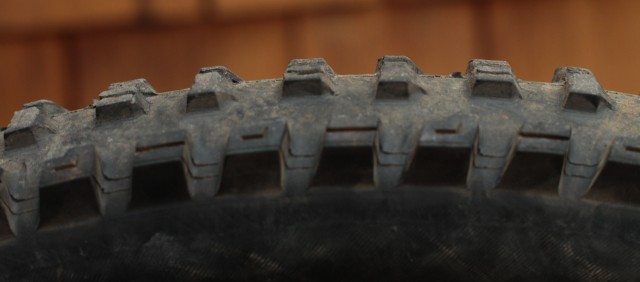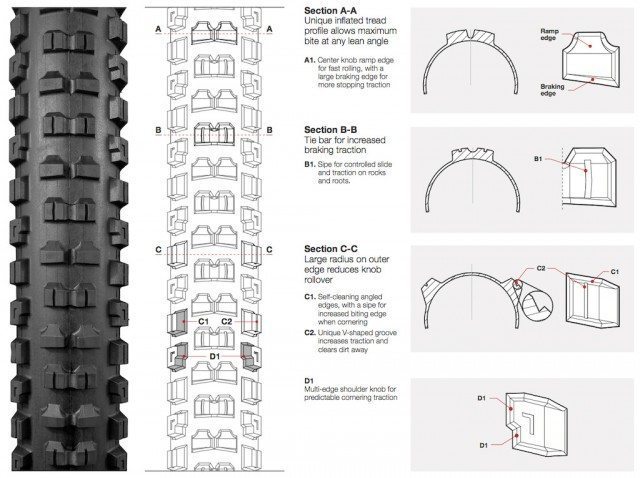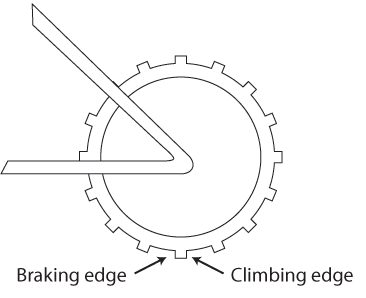
Tire: Bontrager G5
Weight: 2.35 (tested)—1250g; 2.50—1330g
Intended Usage: Gravity-derived poundage
Tested on: 2012 Turner DHR with Mavic 729 rims, with tubes
Days Tested: 20+
Locations Tested: Mammoth Mountain; Northstar at Tahoe; Whistler; Various Pacific Northwest; Tahoe locales
Like most people who are picky about tires, I usually don’t consider Bontrager when it’s time to start replacing worn-out treads. But back when Trek World Racing had a guy winning World Cups, somebody decided to take tires seriously.
A designer named Frank Stacy came up with the G5, and if I hadn’t seen pictures of it, my reaction would have been an extended yawn.
Frank’s name was also associated with the G4, a tire that looked very much like the popular Maxxis Minion DHF tire. The issue was its sideknobs. Every other DHF sideknob has a block that sits at the rear of the knob structure (picture the tire on the ground), that cups dirt in a slightly leaned over braking scenario. The G4 flipped those around, which served no purpose other than to close off the sideknob at full engagement in the dirt, both for cornering and for braking.
When Bontrager started putting out the press releases for the G5, it was the images that got my heart pumping. Frank Stacy knows what’s up if this tire is any indication.
And I should note that the G4 is actually a pretty good tire. The center strip has a lot of surface area and some good ramping—by design it rolls pretty damn well. It just could have been better if Bontrager didn’t blow it on the sideknobs.
The G5 is that better incarnation.
Braking
Like most companies selling tires, Bontrager doesn’t even know how to pump up their own stuff when they nail something. Look at the A-A section in the press release below. They go on about cornering, but the real beauty is that the braking edge on those knobs is cupped, even if just a little bit. This doesn’t have anything to do with cornering other than the fact that the open centerline will keep your wheels planted in a berm turn when the tire sits flat against the riding surface.
When the edge formed by that A-A centerknob pair is on the ground, those two knobs form a little C, with the opening facing the dirt. That’s how you grab material when you slam on the brakes. Something this tire does.
(If you don’t know what I mean by braking edge, here’s a diagram from another review. The braking edge is what defines how well your tire resists rolling when you’re on the brakes.)
The other set of siped center knobs don’t have a cupped cavity, but, since they’re straight, they still grab the dirt. They’re not like some other tires that form a point—I’m looking at you High Roller 1, lots of Schwalbe and Continental tires—that will shoot out from under you when you’re braking.
This combo of center knobs and the spacing between them allows the tire to grab plenty of dirt, and makes this one of the best braking tires I’ve ever ridden. It’s just ridiculously awesome.
In mud, in moon dust, and in surfy sand, the G5 is really, really good. I got a little gum up in some sticky PNW slop and loam, but it didn’t build up to the point where I lost tire contact. I was never riding on a caked-up center knob. I’m not sure I’d call it a mud tire, but in the conditions I’ve ridden in since buying it, the G5 has worked really well.

Unlike the Bontrager G4, the L-shaped blocks on the G5 are on the ride side. If you imagine the tire on the dirt, the knobs referred to as D1 in the press picture form a L on the ground exactly as the letter appears if you’re leaning on the left side of the tire. Even the side knob grabs dirt and helps you scrub speed when you hit your brakes. When the tire tries to wash, that L shape grabs more dirt and keeps the tire under control.
It’s what a Minion DHF does and it’s the opposite of what a G4 does. The G5 brakes like a champ in a straight line and when leaned over.
The key to a good braking tire isn’t more knobs, it’s putting more space between the knobs that are there—those spaces are where the dirt goes. The more dirt the tire grabs, the better it works.

Cornering
I’m going to say something I’ve never said before about any tire. Ever.
Other than riding at Mammoth where any tire swims, the front tire has never washed out on me. Seriously.
I live in some nasty, super dry, deep-dusty terrain, so I’m used to controlling slides in corners that include the front wheel. But that has yet to happen with this tire. I’m sure I can find a slimy root with my name on it to put those words to the test, but it hasn’t washed out yet.
Unlike the Maxxis High Roller 2 and some Schwalbe tires (which have thin litte sideknobs that you can feel fold over and try to kill you), the G5 has structural support and meat that keep the sideknobs from folding over.
Even tires like the Minion DHF and DHR2—which have sideknobs with plenty of meat but aren’t, in my opinion, close enough together—let go at some point. The Maxxis tires still give some resistance even after washing out, but the G5 hasn’t even gotten that far. It’s kind of weird. And kind of awesome.
The G5’s good cornering traction translates well to both wheels. I’ve been able to force the G5 to break loose as a rear tire when I genuinely wanted it to slide, but it takes a lot more force than it would if I were using a different tire.
Rolling Resistance
The G5 brakes like a champ and corners very well, but it’s slower than other tires that have a bigger surface area of centerknobs.
Spacing out centerknobs to get great braking traction means that there’s a lot of knob squishing going on when rolling on the centerline of a tire. Given the only available compound for the G5 is soft, those centers squish out nicely. I don’t usually notice slow rolling front tires on a DH bike since I’m mostly concerned with grip, but on the rear of my bike, I can tell the G5 rolls slowly.
It’s a shame that the G5 is only available as a softy since keeping the exact same mold and going to a 60a compound would still make for a great braking and cornering rear tire that’s just a bit faster.
Bontrager advertises the G5 as a “dual compound” without much more explanation. Just based on feel and looking at the wear, I’d guess there’s a hard compound underlayer, with something in the 40-something “a” durometer rating on the outside. The design is solid though. And if you’re used to riding soft compound rear tires, this isn’t much of an issue.
I don’t think the G5 rolls any slower than any other soft compound tire with well-spaced centerknobs, but since I’m used to running hard rear tires, having these on my bike got my attention.
I don’t even think about the compound when I’m riding a steep fall line or otherwise brake-heavy terrain, but when I’m on wide open, mellower pitches, I wasn’t too keen on keeping the G5 on the rear wheel. It would be a different scenario if Bontrager made a hard compound version.
NEXT PAGE: Wear



Kevin,
Have you had a chance to try out the Michelin Rock’R2? Just curious about them as the G5 still isn’t available in a trail version… yet!
Thanks,
Jim
I have a pair of the Wild’R 2s. I honestly think that’s about the best tread design I’ve ever ridden in terms of sideknob stability. It’s unreal how solid those tires are in corners. Once they do break loose they’re entirely controlled as well. If Michelin comes out with a true dh version that’s got a little larger casing, I’ll probably be kicking the G5s out of bed. However……..
They’re still a good ways from all around perfect. They’re fairly heavy for a trail bike tire and despite all that meat, I’ve still punctured one on the rear within the first few rides. This was on a pair of Mavic Crossmax SX rims which have a pretty hard edge that likes to split beads on tubeless tires, but a tire that heavy shouldn’t puncture at the pressures I usually run. They’re also fairly slow rolling. You’ll definitely notice this, no matter what tires they replace. They also hold mud quite a bit. All those ridges in between the knobs just provide more surface area to hold onto muck and they act like a magnet for it, even in soil that’s not particularly gummy.
I love the tread design. It brakes well, and corners like no other. They need to figure out some casings though, both for a true dh tire and also a preferably lighter trail version that’s a little tougher. Other tire companies have done it, so I hope they stay with this design enough to get it done.
Kevin,
Awesome! Thanks for the detailed response. I’ll pick one up for the front to try out. Are you running the Mag-x front & Gum-x rear? I’ve been running the HR2’s for a while now with good results but I’m interested in trying something new. Any thoughts on how they compare to the rock’r2s?
Thanks,
Jim
Hi Kevin do you know if you can run the G5’s tubeless? Awesome review too.
Cheers Jay
I actually just set one up tubeless on my dh bike yesterday. Like all dh tires, it seated up fine…..I’ve never had an issue with that with any dh casing tire. So yes, it holds air. I don’t know if it’s going to hold up worth a damn, but with as heavy as these tires are, I’d expect them to. I’ll report back if they don’t. But they mate well to industry nine grade rims for what it’s worth.
Kevin,
great review thanks. I bought one to go upfront on my trail / enduro bike when the mud hes away a bit. But, wait, Ive been thinking about that. Specifically about ramped edges and front tyres.
This time of year its not dried yet in the UK so I prefer the Shorty on the rear over, say a DHR11 or Conti Baron as the ramps on those cost traction. Still trying to pedal up those muddy rooty steeps.
The Shorty Maxterra 2.3 is almost as grippy as the Michelin Wild Mud (magiX) and nowhere near as draggy on a fire road. A shrty’s a pretty good rear all year round here .
Thinking about the ramps and the way they affect rear traction made me think about the 2.5 MaxTerra (and MaxxGrip) Shortys I’ve been using upfront. They dont have ramps which plainly costs in rolling.
I am wondering is ramped leading edges give ANY disadvantage upfront at all. And if not maybe the G5 would be just as good as the Shorty in mud ony tne front. (Could be the G5s closed side knob channels will compromise clearing when mud turns to clay, though. I see Mr Gwin opened those channels on “his” version for Onza, the Aquila).
That Shorty upfront does grip across cambers very nicely (especially in macxgrip compound) but going by your G5 comments maybe the G5 would even beat it.
Love the detail on tread design man. Thanks for the thorough review.